PC gamers believe more is better, and that philosophy applies to everything in the gaming universe. In fact, there is nothing that could reel back the ambitions of a gamer in his prime — except for the price tag. And this is where video card makers like Nvidia smartly decide to add tiers to their video cards catalog, allowing buyers to level up as they make more money. So just below the legendary 3080 video card, which allows you to breeze through 4K gaming, you have the GeForce RTX 3070, which is fantastic for gaming at 1440p resolution. But Nvidia adds temptation here, too — why not consider the 3070 Ti, while you’re looking at the 3070? It’s a fair question, and to find out which one of these cards is more suitable for you, keep reading!
3070 vs 3070 Ti – Quick Comparison
Going for a 4K gaming setup can get expensive quite quickly. Not only do you need a much more expensive graphic card, but you also need a 4K monitor, a capable CPU, games that support it, and a killer broadband connection. But mainly, you don’t want to compromise on frame rate. In comparison, 1440p gaming sounds great, as you can manage with lesser resolution but still enjoy a highly responsive gaming session. This is why it makes a lot of sense, even in 2022, to invest in either the Nvidia GeForce RTX 3070 or the 3070 Ti!
Video cards are more than just their specs sheet, but that doesn’t mean we don’t inspect the specifications closely. Here’s a table looking at the basic stats of the 3070 and 3070 Ti.
| Features | RTX 3070 | RTX 3070 Ti |
|---|---|---|
| GPU | GA104-300-A1 | GA104-400-A1 |
| Architecture | Ampere | Ampere |
| Manufacturing Process | 8nm | 8nm |
| Interface | PCIe 4.0 | PCIe 4.0 |
| CUDA cores | 5,888 | 6,144 |
| Tensor cores | 184 | 192 |
| RT cores | 46 | 48 |
| Base clock | 1,500 MHz | 1,575 MHz |
| Boost clock | 1,725 MHz | 1,770 MHz |
| Memory | 8GB GDDR6 | 8GB GDDR6X |
| Memory speed | 1,750MHz | 1,188MHz |
| Bandwidth | 448GBps | 608GBps |
| Memory bus | 256-bit | 256-bit |
| TDP | 220W | 290W |
That’s the summary of the GeForce RTX 3070 against the RTX 3070 Ti. Let’s take a look at the pros and cons of each.
GeForce RTX 3070
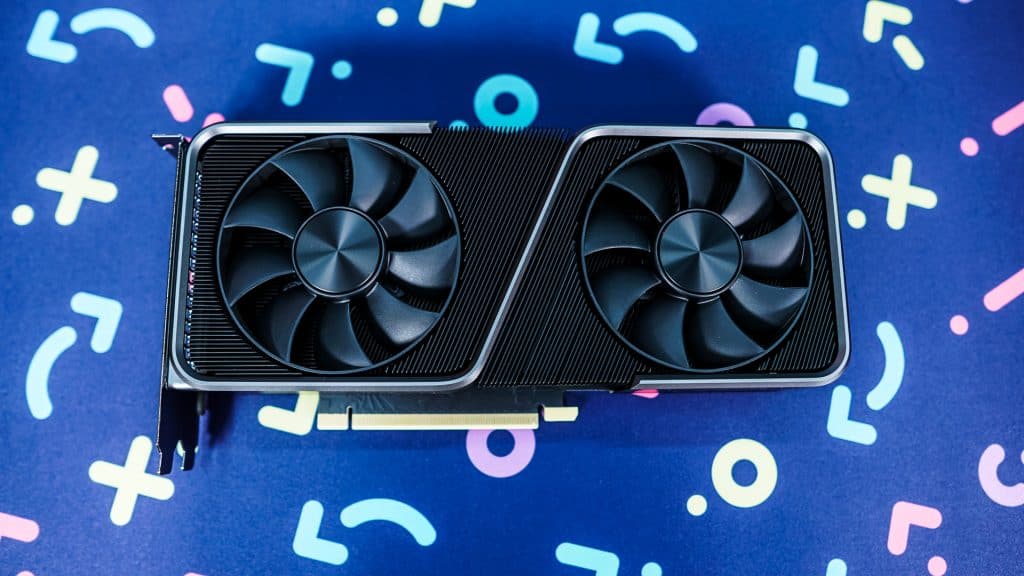
Pros:
- Fairly quiet
- Is cheaper than the 3070 Ti (provided you find a good deal)
- Good value for money
- Will easily meet your expectations for the next two years of gaming
Cons:
- Overclocking can get complicated due to power limits
- Proprietary 12-pin adapter
GeForce RTX 3070 Ti
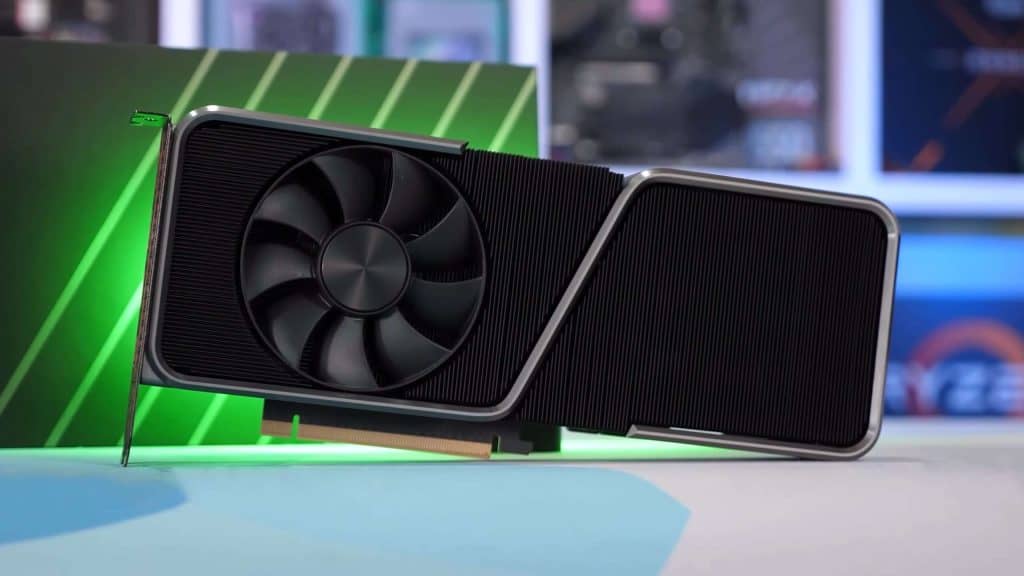
Pros:
- Good cooling
- Better at 4K gaming than the RTX 3070
- The Founders Edition design is stunning
Cons:
- Consumes more power than the 3070
- Mismatch between price and performance
- No USB-C
- The 8GB memory limitation may restrict 4K gaming in the future
3070Ti vs 3070 – Key Specifications
Given the strange GPU market at the moment, with volatile pricing, price-gouging from middlemen, and general unavailability of units thanks to crypto mining and logistical issues, you might be asking yourself if the price difference between the RTX 3070 and 3070 Ti is really worth it.
Since the 3070 Ti is a follow-up to the extremely popular RTX 3070, they have a lot in common. But since we’re looking for differences, we broke this comparison down into sub-sections that we could inspect further, starting with the architecture.
Architecture
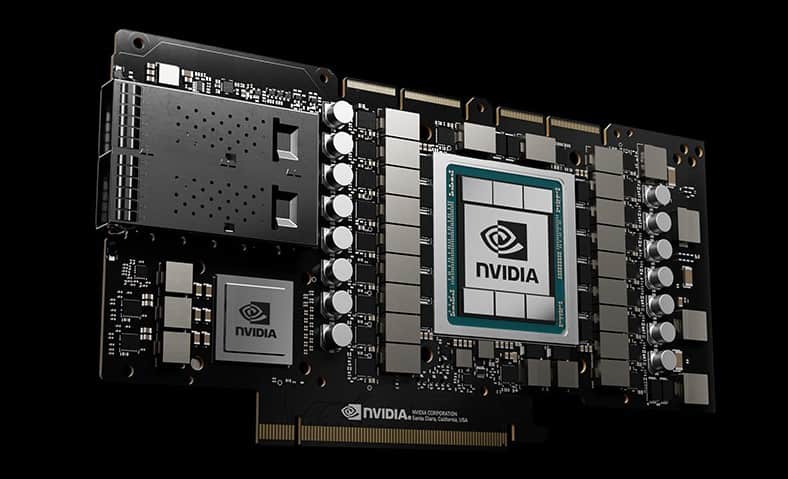
The 3070 and 3070 Ti are both built around NVIDIA’s Ampere GPU architecture which was introduced in 2020. Built with the 8nm process, the 3070 and 3070 Ti both have a die size of 392mm2. The 3070 is based on the GA104-300-A1 GPU compared to the GA104-400-A1 of the 3070 Ti — essentially, it’s the same chip, but the 3070 Ti pushes it to its limits. Since there’s nothing radically different here, we can declare this section a tie.
Clock Speeds & Overclocking
Now, we begin to see differences as the 3070 has a base clock speed of 1500MHz, compared to the 1575MHz offered by the 3070 Ti. The 3070 Ti trumps the 3070 with a faster boost clock speed of 1770MHz compared to 1725MHz on the 3070. While the 3070 Ti clearly wins this round, we must warn you to be cautious if you plan to overclock either of these cards as different users report different voltage/frequency combinations that work for them. The best way to find what works for your card is to try different settings and incremental changes.
| RTX 3070 | Boost Clock | RTX 3070 Ti | Boost Clock |
|---|---|---|---|
| ASUS ROG STRIX RTX 3070 GAMING OC | 1,905 MHz | ZOTAC RTX 3070 Ti AMP Extreme Holo | 1,890 MHz |
| ASUS ROG STRIX RTX 3070 V2 GAMING OC | 1,905 MHz | GIGABYTE AORUS RTX 3070 Ti MASTER | 1,875 MHz |
| MSI RTX 3070 SUPRIM X | 1,905 MHz | Colorful iGame RTX 3070 Ti Vulcan OC | 1,860 MHz |
| Colorful iGame RTX 3070 Vulcan OC | 1,875 MHz | EVGA RTX 3070 Ti FTW3 ULTRA | 1,860 MHz |
| Colorful iGame RTX 3070 Neptune OC | 1,845 MHz | GALAX RTX 3070 Ti HOF Pro | 1,860 MHz |
Cores
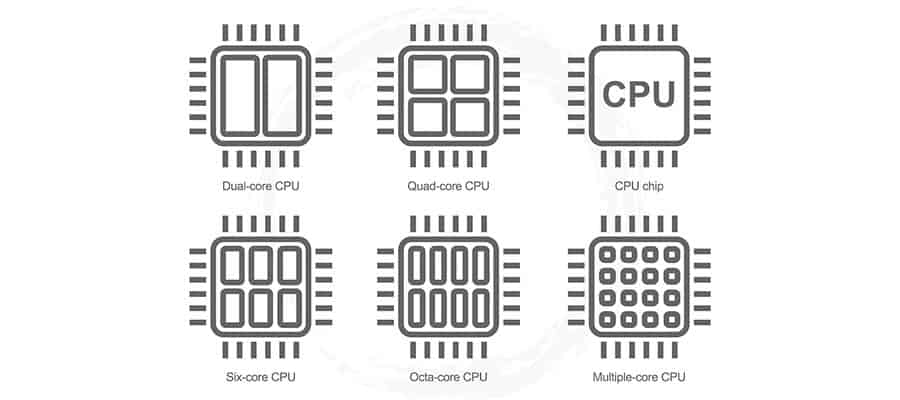
When it comes to cores, the 3070 Ti takes the lead again as it flexes hard against the 3070 — it packs 6,144 CUDA (Compute Unified Device Architecture) cores compared to the 5,888 in the RTX 3070. Similarly, it leads in the number of Tensor cores (which handle all the heavy lifting that machine learning requires, so if you’d like to thank anyone for the rendering of great graphics at higher frame rates, this is it!) as well, with 192 cores against the 3070’s 184.
VRAM & Memory Specs
Both the 3070 and 3070 Ti feature a 256-bit memory bus or interface and have 8GB of VRAM, but look closer, and you’ll see that the 3070 Ti has 8GB of GDDR6X whereas the 3070 has 8GB of GDDR6. GDDR6X may be more power-efficient on paper, but it’s undoubtedly more power-hungry in a real-life scenario. But the solution is good cooling!
That said, when it comes to performance, GDDR6X crushes GDDR6. Where VRAM plays a critical role is when you’re playing at a higher resolution, you can see the 3070 Ti struggle less with frame drops than the 3070. The memory speed is higher on the 3070 as well, as it rocks 1,750MHz, a tad higher than the 1,188MHz offered by the 3070 Ti. While VRAM is not a critical factor when choosing a good video card, in this scenario, it does help the 3070 Ti get a lead over the RTX 3070!
Additionally, the VRAM bandwidth is also higher on the 3070 Ti at 608.3GB/s. In comparison, the 3070 is restricted to 448GB/s.
Shaders, RT Cores, and TMUs
Before we give you stats for shaders, RT cores, and TMUs, let us first explain what these are for those who may not know! Shaders are not just visual effects that implement shading in your games. They’re programs; various types of shaders like the Geometry or Vertex shader bring life to the 3D models by managing the rendering of an object’s vertex positions or its geometry. At the same time, Pixel or Fragment Shaders take on everything else, like the colors of each of the pixels or fragments.
RT cores or ray-tracing cores are designed to do a much better job of handling light reflection and geometry better during gaming than your typical GPU cores. Ray-tracing tech is a big reason for the popularity of Nvidia cards among gamers, and you can definitely give all the credit to RT cores!
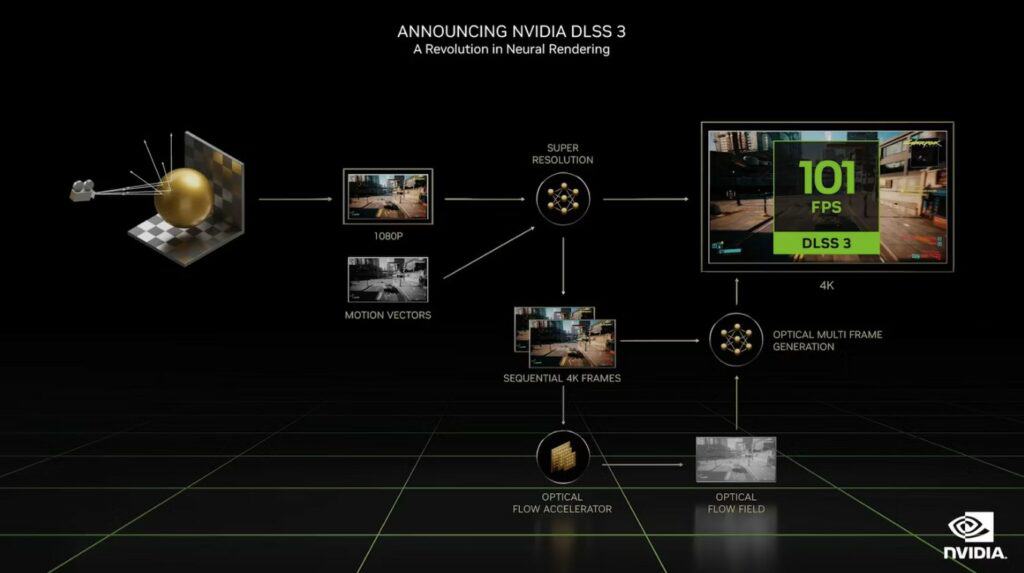
Nvidia’s DLSS technology (Deep Learning Super Sampling) is possible due to Tensor cores, which are responsible for all the AI magic that happens on Nvidia cards, allowing you to enjoy great frame rates with impressive graphics, and this is thanks to DLSS doing a much better job of rendering rapidly while using fewer system resources, making it a very efficient job. Texture Mapping Units or TMUs tackle the job of converting 2D images in the game into playable, interactive 3D graphics.
Whew! With that out of the way, here are the numbers — the 3070 Ti has 48 RT cores compared to the 46 in the 3070. Similarly, it has 192 tensor cores as well as 192 TMUs against 184 tensor cores and 184 TMUs inside the 3070. It’s a similar story with shaders, too, as the 3070 Ti has 6144 shaders while the 3070 has 5,444 shaders. Easy win for the 3070 Ti, yet again.
Performance / Resolutions
Plenty of industry veterans have run benchmarks and numerous tests on the RTX 3070 and its stylish younger brother, the 3070 Ti. The consensus is unanimous— when it comes to performance, the 3070 Ti is the clear winner. While both work tremendously well with 1440p gaming, both cards can manage 4K gaming as well, but the RTX 3070 clearly struggles more than the 3070 Ti.
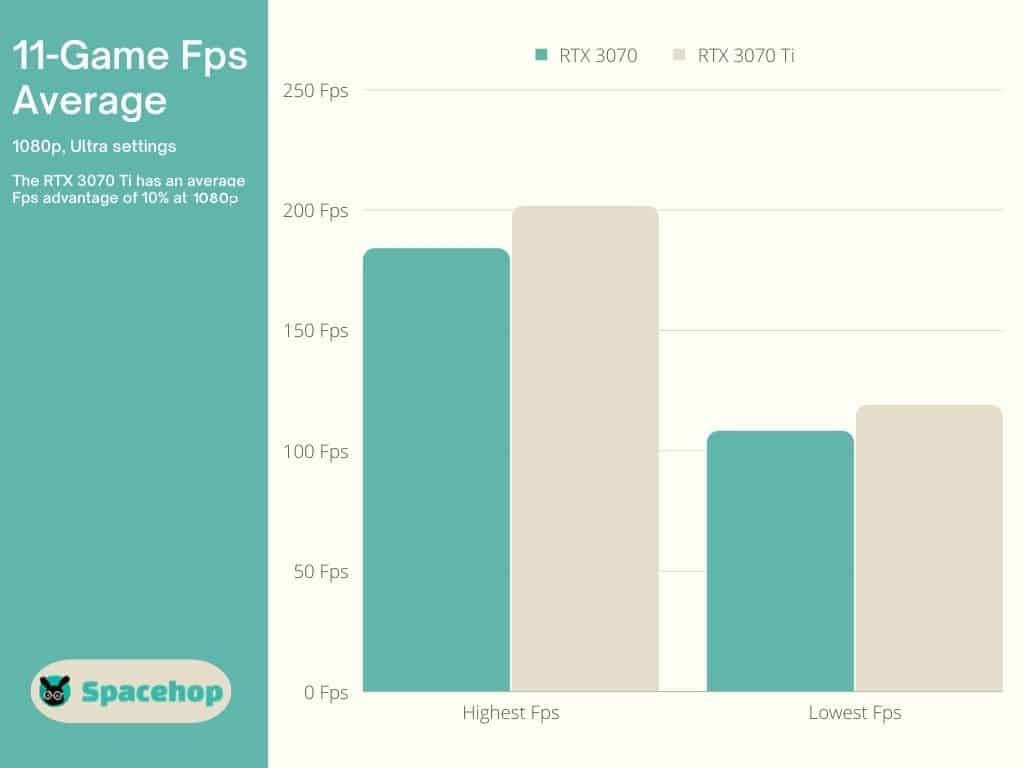
The RTX 3070 Ti has 10% better Fps performance at 1080p in-game benchmark tests.
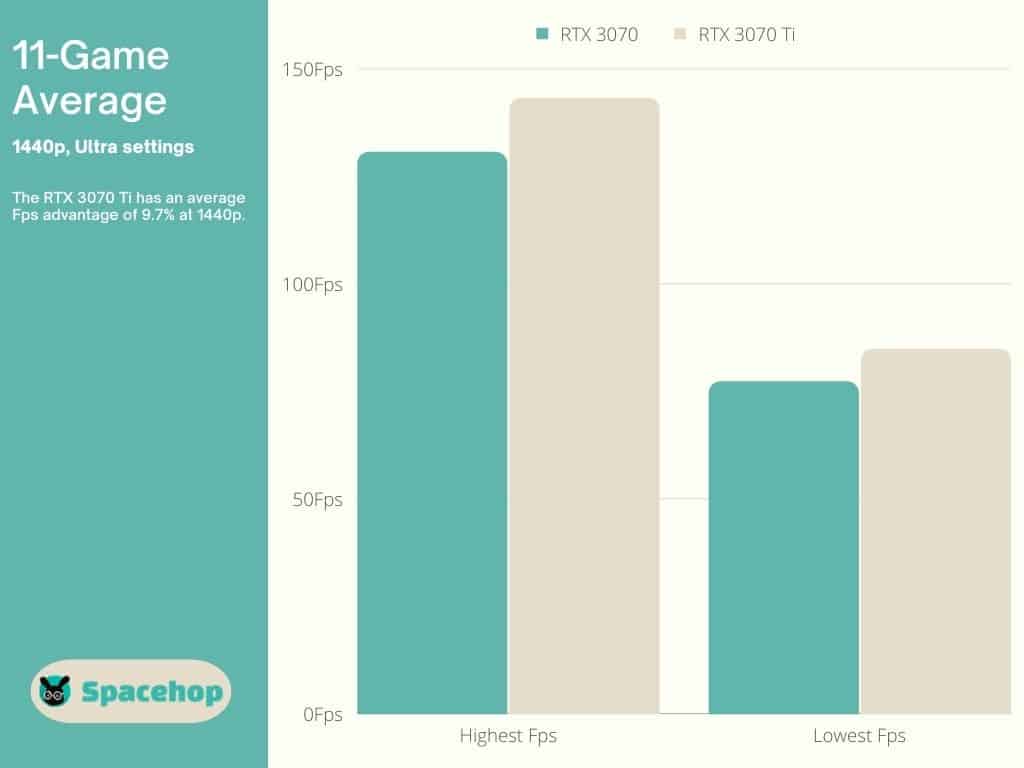
The RTX 3070 Ti has 9.7% better Fps performance at 1440p in game benchmark tests.
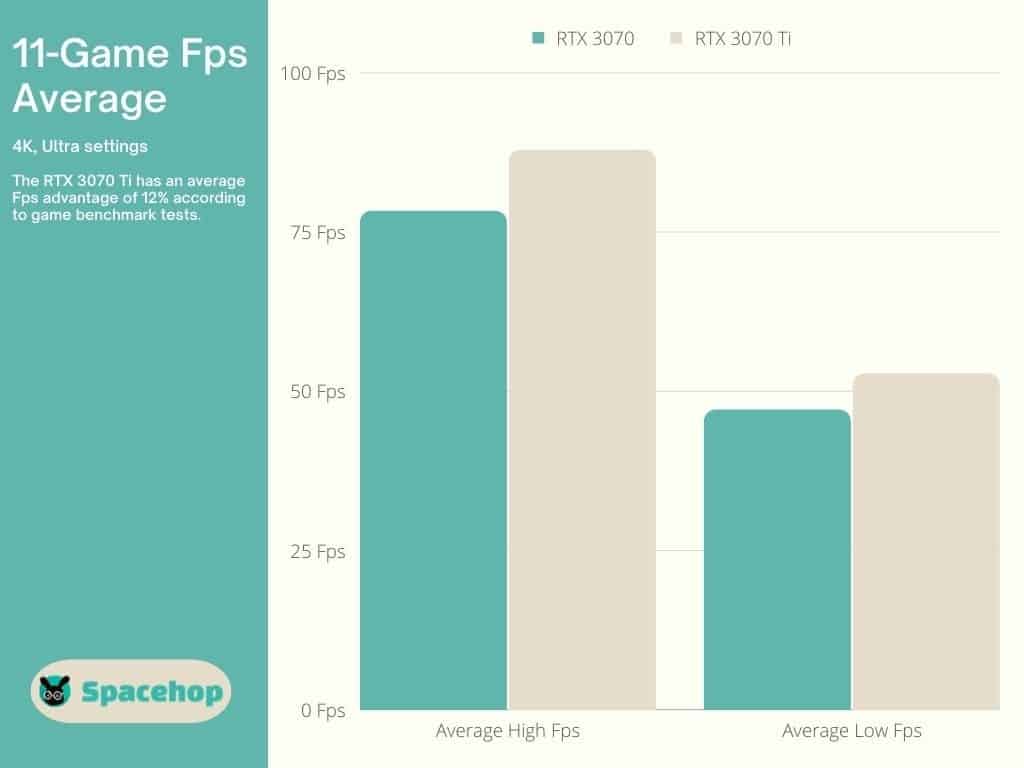
The RTX 3070 Ti has 12% better Fps performance at 4K in game benchmark tests.
That said, the difference isn’t crazy enough for us to push users to buy the 3070 Ti over the 3070. The answer is a bit more complex — after all, the price difference is significant and the actual gaming improvements are marginal. If you want hard numbers, you’re looking at an improvement of about 8-12 FPS (frames per second) while playing games, and when it comes to resolution, you could up the settings about one notch higher, but don’t expect anything close to what you’d get from, say, an RTX 3080, which is a beast when it comes to 4K gaming.
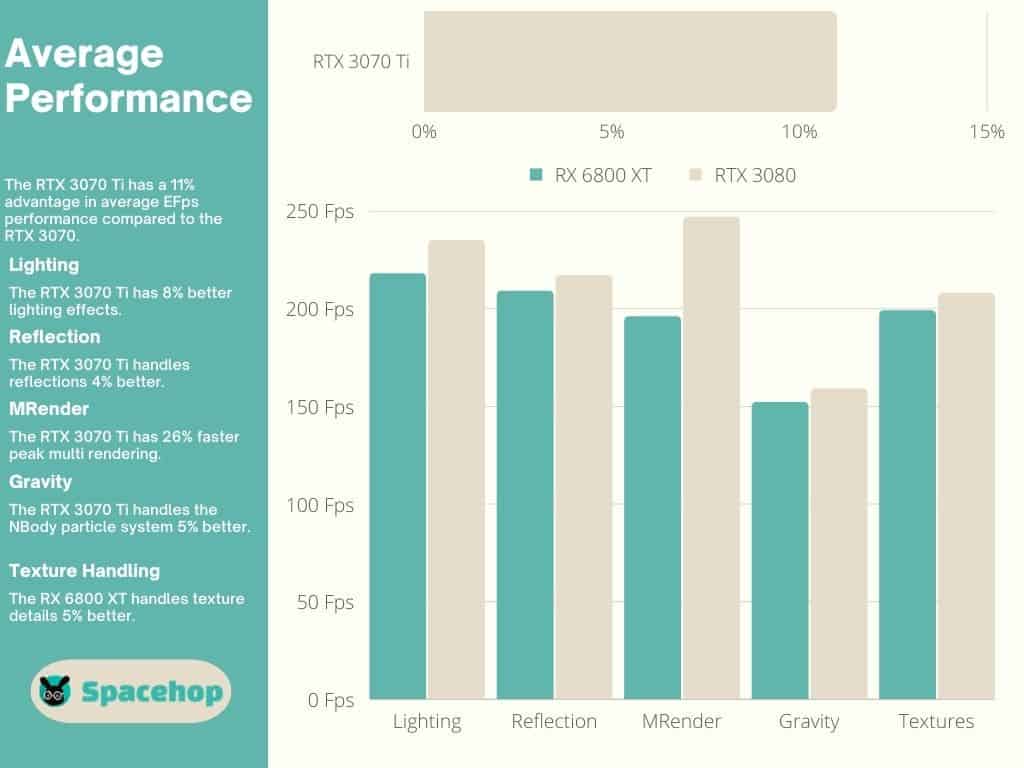
Even user tests have the 3070 Ti at an advantage of just 8% in effective speed and an average score advantage of 11%. When overclocked, this difference remains at 11%, certainly not enough to justify an upgrade from one to another.
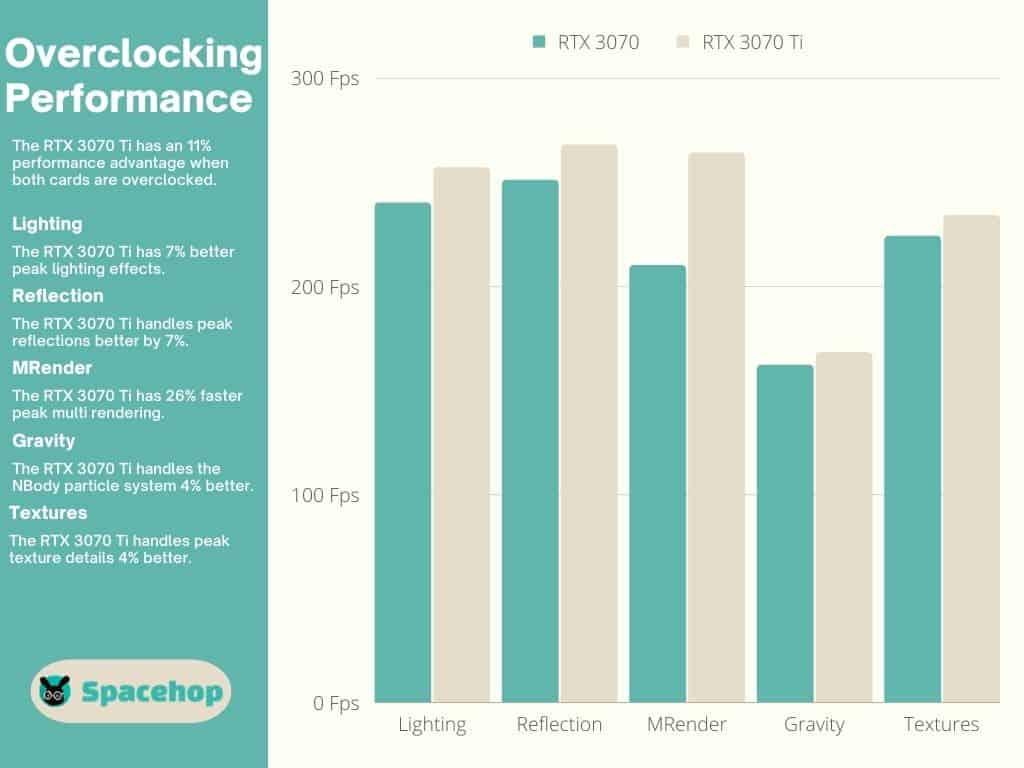
Related Read: Our 3070 Ti vs 3080 comparison
Connectivity
Both cards connect to the system via a PCI-Express 4.0 x16 interface, and when it comes to display outs, both the 3070 and the 3070 Ti feature three DisplayPort 1.4 outs and a single HDMI 2.1 output. This allows you to connect up to four displays, and since both these cards have the same number of outputs, this round is a draw!
And if you were hoping to link up either of these cards with another Nvidia card using SLI (Scalable Link Interface) or NVLink, unfortunately, that tech is not supported by the 3070 or the 3070 Ti.
TDP
The TDP or thermal design power (also referred to as thermal design point) is the maximum amount of heat generated by your GPU. The RTX 3070 has a TDP of 220 watts, whereas the 3070 Ti bumps that number up to 290 watts. This automatically means you’ll need to pay more attention to the cooling requirements of the Ti, especially if you’re building your PC yourself. And yes, this also means you’ll get higher power bills, especially if you’re running the card for mining activities. So it’s a thumbs up for the RTX 3070 for this round!
Standout Features
Now that you’ve seen the real deal with the 3070 and the 3070 Ti, a few things are pretty obvious.
If you’re looking for a 4K gaming card, neither of these two cards is a great choice. And if you’re looking for a great 1440p gaming card, then both the 3070 and 3070 Ti will do a great job with your gaming graphics. And while the 3070 Ti puts up better numbers, it really boils down to the deal that you find.
We wouldn’t recommend that you pay through your nose for a 3070 Ti, and if possible, we’d recommend that you get the 3070 for now. After all, you can always sell your 3070 at a later point, when you decide to upgrade — currently, the used GPU market is extremely hot.
Price
The RTX 3070 made its debut on September 1, 2020, at a price of $499 while the 3070 Ti came with a price tag of $599 when it was unveiled on June 10, 2021. Now you might be able to get your hands on an ASUS or MSI RTX 3070 but it will be tricky (read: extremely difficult) to find an Nvidia card as scalpers and crypto miners have made things very difficult for gamers.
Here are a couple of links we were able to find on Amazon for both the 3070 and the 3070 Ti:
There’s no saying how high or how low the prices can be on certain days, as the demand and supply are really volatile. There is no doubt that you’ll have to actively follow the market closely to make sure that you find a good deal, and we wish you luck!
Conclusion
It’s the current scenario that makes it difficult for us to really draw a conclusion in this Nvidia GeForce RTX 3070 vs 3070 Ti GPU comparison, as the original prices seem fair to us, and if they were the norm, we would recommend the 3070 Ti over the 3070. But if you are paying more than a hundred dollar difference for the Ti, then we really wouldn’t suggest it. But these are times when any card is better than no card, so we totally get it if you decide to go for a Ti card! And if you have any more specific questions about either of these cards, our comments section is open for your questions!